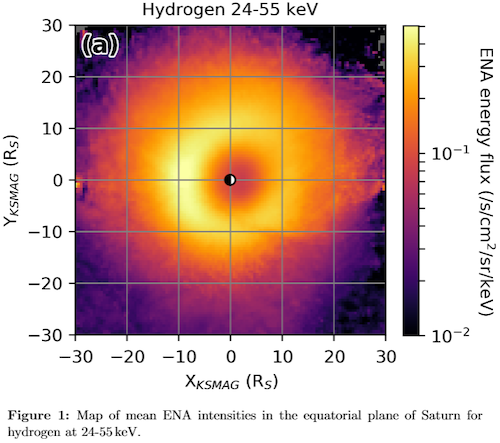The statistical morphology of Saturn’s equatorial ENA projections
- 1Department of Physics, Lancaster University, Lancaster, UK (j.kinrade@lancaster.ac.uk)
- 2APL, John Hopkins University, Laurel, MD 20723, United States
- 3Department of Physics and Astronomy, University of Leicester, Leicester, UK
Saturn's magnetosphere is an efficient emitter of Energetic Neutral Atoms (ENAs), given the presence of an extended neutral cloud around the planet that originates from the icy moon, Enceladus. The ENA emission is symptomatic of the global circulation of plasma in Saturn's magnetosphere. Energetic ions are injected from the outer magnetosphere following magnetotail dynamics and reconnection events. These ions then charge exchange with the neutral cloud, which is mostly confined to the spin plane, resulting in ENA production. The global ENA emission is dynamic, displaying sudden brightening on the nightside, and discrete rotating enhancements which circle the planet for many hours as energetic ions drift with the bulk plasma flow. These latter features have been linked with rotating signatures in the ultraviolet auroras, suggesting coupling via some transient system of field-aligned currents that forms following injection events. Indeed these injection events occur so often as to form Saturn’s dawn auroral arc.
Our characterization of the ENA emission at Saturn is made possible using imagery from the Ion-Neutral Camera (INCA) that flew onboard Cassini. Observations were made over the entire mission lifetime. We present for the first time a statistical analysis of the complete INCA image set, using equatorial projections of the flux distribution to reveal the time-averaged morphology of Saturn's ENAs.
We used a comprehensive data processing and equatorial projection algorithm to calibrate, clean and filter for all high inclination orbit days. In the final average pictures, many of the projected pixels consist of between tens to hundreds of days continuous exposure, all captured with a line-of-sight > 50° elevation (above the projection plane) and within 30 RS distance from the spacecraft.
We find clear toroidal ENA distributions in O and H, and all INCA energy bands, with the emission dropping off sharply inside 5 RS radial distance in all cases. Average peak intensities occur at radial distances from ~7 RS (O, 170-230 keV) to ~10 RS (H, 24-55 keV). All toroids are offset towards the dayside by several RS, most clearly in the 24-55 keV H image, with a maximum intensity at ~13-14 RS from the planet centre on the dayside, compared to only ~10 RS on the nightside. The H ENA distribution is also enhanced around midnight local times, as previously observed in an early morphological study of 2007 data by Carbary et al. [2008], a net effect associated with reconnection return flows and transient ENA enhancements in this sector.
We also explore possible organisation of the average global ENA intensity by Saturn’s rotating current systems associated with planetary period oscillations (PPOs, e.g., Provan et al. [2018]). We find that the ENA intensity is statistically modulated by periodic changes in expected plasma sheet thickness as controlled by field-aligned current interactions, a pattern evident in both north and south rotating system frames. With a thicker plasma sheet, more energetic ions are available to charge exchange within the background neutral cloud, and the LOS integral measure increases as a result (and vice versa). In this long-term picture, this effect may dominate over other possible PPO modulation effects on the appearance or evolution of transient ENA injection signatures.

How to cite: Kinrade, J., Bader, A., Badman, S., Paranicas, C., Constable, D., Arridge, C., Cowley, S., Provan, G., and Mitchell, D.: The statistical morphology of Saturn’s equatorial ENA projections, Europlanet Science Congress 2020, online, 21 Sep–9 Oct 2020, EPSC2020-287, https://doi.org/10.5194/epsc2020-287, 2020.

